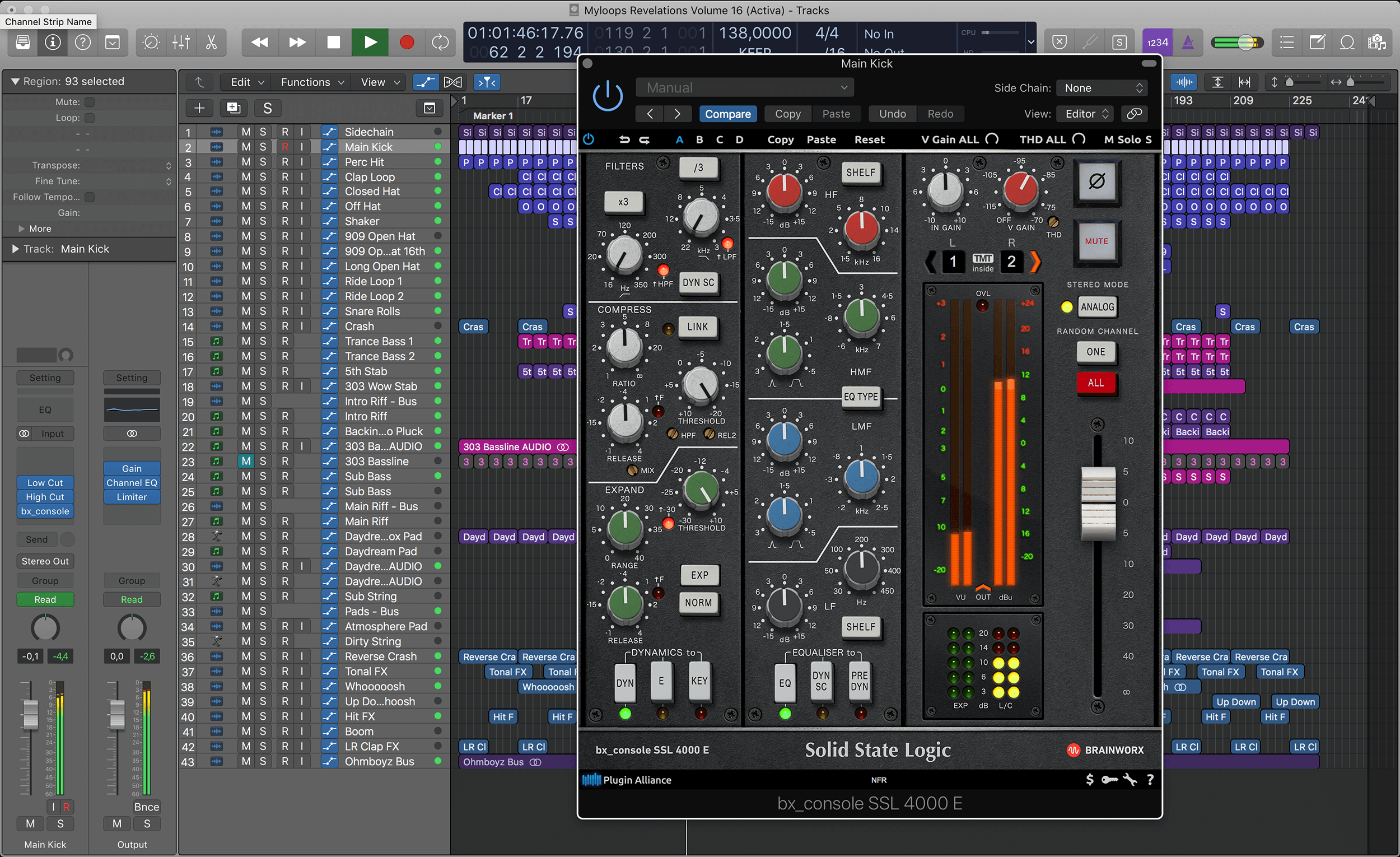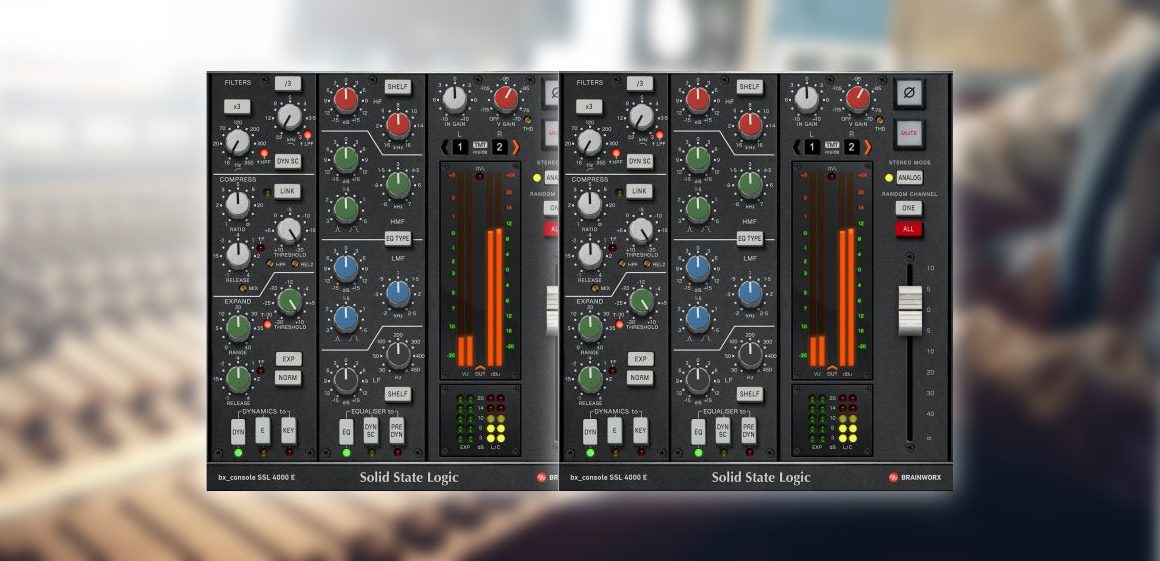Comments
- Brainworx bxconsole SSL 4000 E. Approved by Solid State Logic (SSL). 72 channels of classic E series, injected with patent-pending Tolerance Modeling Technology.
- Plugin Alliance BX Console SSL 4000 E & G Review. If you’re looking for some analog mojo and magic in your DAW of choice, you simply can’t go wrong here.
Channel strip plug-in emulates E Series SSL with G Series features Plug-in developers Brainworx have released bxconsole E — a new 72-channel emulation of the SSL E Series console, complete with compressor/limiter, expander/gate, four-band parametric EQ, and wide-ranging high- and low-pass filters.
Brainworx Ssl 9000
- Interesting, I'll check this out tomorrow. I really like the E, but the low mid frequency knob is waaaaay off.0<=' span='>0
- edited October 13
Have you got the new version or the original one? Apparently SSL engineers assisted with the new endorsed version. I've seen a few blind tests between the various SSL plugins and SSL hardware, and the answers have been all over the place. Do you have experience with a real SSL 4000 E console?Interesting, I'll check this out tomorrow. I really like the E, but the low mid frequency knob is waaaaay off.'For a man to conquer himself is the first and noblest of all victories.'0<=' span='>0 - Got into both of these recently...great on kick drums, so easy to dial in the meat.0<=' span='>0
- edited October 13
I got them both on sale for $25 ea (with vouchers), along with the Townhouse 'SSL' compressor for a bit less. They work great with Nebula SSL 4000 console emulations, and the usability is really good for mixing. I usually add some Neve or API flavours when tracking as part of my workflow, which adds a bit of depth to the sound. They are definitely near the top of my algo plugins list.Got into both of these recently...great on kick drums, so easy to dial in the meat.'For a man to conquer himself is the first and noblest of all victories.'0<=' span='>0 - Yeah I got them pretty cheap with vouchers too
Glad I did though. Dont have the townhouse though, I went for the shadow hills instead and I really dont have good enough ears to get the best of that one!0<=' span='>0 - edited October 13
Isn't the Shadow Hills a mastering compressor? The Townhouse is a cobbled together G Bus Comp that can also be used on drums and bass, etc. It's always the 1st plugin on my mix bus to add some 'glue' and I usually mix into it.Yeah I got them pretty cheap with vouchers too
Glad I did though. Dont have the townhouse though, I went for the shadow hills instead and I really dont have good enough ears to get the best of that one!'For a man to conquer himself is the first and noblest of all victories.'0<=' span='>0
I've got no idea, whichever one plugin alliance are selling now - I bought it about 3 months ago.
Have you got the new version or the original one? Apparently SSL engineers assisted with the new endorsed version. I've seen a few blind tests between the various SSL plugins and SSL hardware, and the answers have been all over the place. Do you have experience with a real SSL 4000 E console?Interesting, I'll check this out tomorrow. I really like the E, but the low mid frequency knob is waaaaay off.
I'm not questioning the authenticity, or casting a judgement on it vs. any other ssl style channel strip - it's just that low mid frequency knob does stand out like a sore thumb. If you switch it to the other 'EQ type' it's within the realms of what the knob says.
I'm cool with gear not quite doing what it says on the controls, but being out by a factor of 2 is quite extreme. And I don't have experience of the real deal (the only top tier console I've ever experienced in person long enough to form an opinion is a Neve 80 series), but I'd be surprised if it was that far out.
The Focusrite strip (which is also quite nice) has a different oddity; on the upper mid and high shelf bands, the gain knob does about 1/2 of what it says. I was surprised that in some cases I was pushing up towards a +10dB high shelf until I tested it and saw it was actually barely +5. Kinda gave some of the comments on Gearslutz about it having such 'smooth high boosts' some context.0<=' span='>0- I see UAD do the SSL E strip and also a bundle with the G compressor .. a little pricey though, and their deals don't seem to be as good as Brainworx offerings ....
Going to dowload a demo from Plug Alliance and then wait and see if they'll have a deal anytime soon ..
Also see the Focusrite SC at a ridiculously cheap price on a well-known auction site ....
How does that, or doesn't it, compare ?0<=' span='>0 - edited October 13
The best deals are usually just after the deal has endedI see UAD do the SSL E strip and also a bundle with the G compressor .. a little pricey though, and their deals don't seem to be as good as Brainworx offerings ....
Going to dowload a demo from Plug Alliance and then wait and see if they'll have a deal anytime soon ..
Also see the Focusrite SC at a ridiculously cheap price on a well-known auction site ....
How does that, or doesn't it, compare ?
I haven't tried the Focusrite, I'm mostly into Neve, API & SSL emulations.'For a man to conquer himself is the first and noblest of all victories.'0<=' span='>0
- Sound
- Features
- Ease Of Use

Brainworx BX consoles E and G Review
These are channel strips plain and powerful. They sound great, are very flexible, and very similar!
Pros
– True to the ‘SSL tone’
– Light on the CPU
– Great control over the analog noise and distortion
Cons
– Not cheap, especially if you can’t decide between the two!
Plugin Alliance has, over the last few months, released several different console emulations to fit across your mix in a DAW, creating the analog inconsistencies and quirks that please the ear when it comes to making music out of the box.
In this review, I’ll walk through the structure for two of the emulations, as they’re identical with a couple exceptions, and then I’ll do my best to compare and contrast the ‘tone’ created by the emulations of the different desks, and what you can expect them to do when put on your mix.
These console emulations are of two SSL desks, one from the 70’s, and one from the 80’s, complete with the different characteristics that each console had.
The emulations each contain 72 channels, with extremely subtle tonal differences within the filter, compression, expander, gate, and EQ modeled on the original strips on the desks. More on this in a bit.
These plugins contain all the elements that were present on each channel, with the addition of some new hybrid elements that weren’t on the original, to bring the plugins into contemporary digital mix world.
Ssl 4000 E Vs G
Each plugin has 3 main sections; dynamics, EQ and the metering/Channel selection. Dynamics and EQ can be turned on and off at the bottom of each section.
Dynamics contains:
2 filters, Hi-pass and Lo-pass. You can triple the frequency range of each filter, as well as place it on the inputs of the Compressor if you wish.

The classic SSL compression is here, in its simple form. No menu diving on this one, there’s 3 basic knobs; ratio, threshold and release. The attack is automatic, unless you press a button to override to a fast attack.
One thing I absolutely loved about the compressor was the Mix control – adding dry signal back into the compressed sound, so if you’re too lazy to buss to parallel comp, you can do it all there in the plugin. Brilliant.
You can also stereo link if it’s a stereo signal, giving smoother stereo compression, instead of dual mono.
Expansion/gate. You can switch between the two here. Again it’s a simple powerful affair, with range, release, threshold and hysteresis knobs. The range affects the gain reduction, and the threshold dictates at what level the gate/exp kicks in. You can also switch to the inverse signal (you only hear the ducked signal).
The dynamics section can be swapped between the two series, so you can have the E or G dynamics on either plugin. This is fantastic, almost giving you 2 plugins for the price of one.
You can switch out depending on whether you want the more colourful E comp or the tighter more precise G comp, along with the exp/gate and filters that come with it.
The side chain is available on all the dynamics processing on both plugins. I absolutely love sidechaining, as I find it tightens up my mixes immensely. I’ve never done much sidechaining other than with compression, but using it with a gate was a great learning experience. Being able to open the gate on any track when the Kick hits can really tighten up a mix rhythmically.
EQ section
Brainworx Ssl 4000
The EQ is 4 band – 2 shelves and 2 parametric bands. Each of the plugins has a switchable EQ type – in the E console it’s black and brown knob, and with the G it’s orange and pink knob.
Brainworx Bx Solo
On the G series, with the pink knob, there’s a x and / by three for the High mid and low mid freqs for a slightly wider frequency range than the E series.
I found the G series EQ slightly more aggressive in its sculpting than the E series, especially the pink knob version. It gave some serious punch to drums, compared to the other EQ’s. Both EQ’s are very flexible, with distinct tonal characteristics.
I also found the G to sound warmer to my ears. Less cutting than the E. But I definitely found that material responded completely differently to the two EQ’s, and your ears will pick up and appreciate different EQs for different source material.
Having the different colour knob flavours just gives you more choice to pick from! You can place the EQ before, in the middle of (side chain), and after the dynamics section.
Metering
This is not just the basic utilitarian section. Yes, it has metering of the main signal, expansion and compression, in and out gain, phase and mute; all the standard bits on a metering section. But the additions to my mind are where the BX console plugins start to stand apart from their competition.
TMT – this element is what sets the BX consoles emulations apart, to my mind. Not only does the plugin emulate the hardware, it goes channel to channel, and emulates the tiny tonal differences between each channel, from each section.

Once you’ve instantiated the plugin on several (or all) your tracks, you can control which ‘channel’ of the mixer each track runs through. You can go through and select a channel on each track, you can randomise one track, or you can randomize all your tracks at once. Heard one channel at a time, I could sometimes hear distinct differences in the way the plugin responded to the source material.
Sometimes I couldn’t hear any difference at all. All your settings are kept the same, so you’re simply clicking through the different channels, until something pops out, or you give up. But where this truly shines, to my ears, was on full mixes.
As our favourite philosopher, Marilyn Monroe, once said, “Imperfection is beauty”. Where this plugin really sings is where the ear picks up on slight imperfections in the sound, making the overall picture richer, fuller and wider.
Flicking through the ‘random all’ button I found caused really interesting changes in the mix – stuff would get darker, or closer, or stick out a bit. You can turn the TMT off, and have every channel identical, which is a good way to check you’re not going mad, or convincing yourself of something that’s not there!

The V-gain knob adds analog noise to the signal. It’s slightly fluctuating, and changes depending on the channel, so it’s not just straight noise. There’s thought gone into the noise! I really like the fact that you can choose whether to have the analog noise in or not, and you can adjust the amount. Per channel.
THD – this is possibly my favourite little knob in these plugin series. It adds harmonic distortion to each channel separately.
The combination of this and the modeling of slight differences in each channel just give the analog flavor, that warmth, color, grit that you might be looking for.
I love that you can dial it in per channel, so if you want some guitars dirtied up, but you want to keep the percussion and piano cleaner, then it’s as simple as turning some knobs, to get more of that analog distortion, and still keep the clean digital signal running through other channels. Here’s a (low quality) video showing Dirk explaining how the console itself had varying tolerances between each channel on his (and other) consoles.
Brainworx Ssl 4000 E Reviews
I also like the surprisingly low CPU putting these plugins across the whole mix. It gives you all the basic sound shaping requirements you need on every channel. If only there was something like the Console 1 to enable you to use hardware mapped automatically to the plugins across the mix. That would be extremely useful!
Conclusion
These are channel strips plain and powerful. They’re designed to lay across all the channels of your final mix, so they’re coded light on CPU. They sound great, are very flexible, and very similar.
The differences tonally are there, but the best way to decide which you prefer is to demo them yourselves. I personally preferred the G console. I felt it was easier for me to give mixes more punch, and weight. But I did love the fact that you could swap out EQ’s and Comps on both plugins, giving you a lot of variety within the plugin. I absolutely loved the control over the analog noise and distortion, and the extra flavor the TMT brought.
Highly recommend both – but definitely check the demo versions to see which your ears prefer!
They’re $299 apiece, but who knows what the Christmas sale will bring!! More info on the Plugin Alliance website.
DISCLOSURE: Our posts may contain affiliate links, meaning when you click the links and make a purchase, we receive a commission.